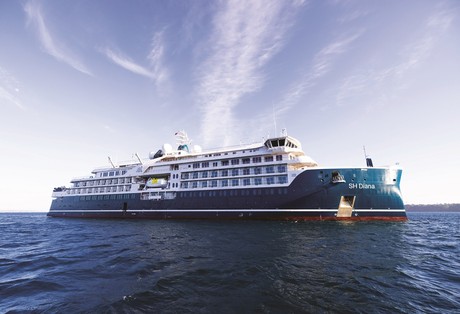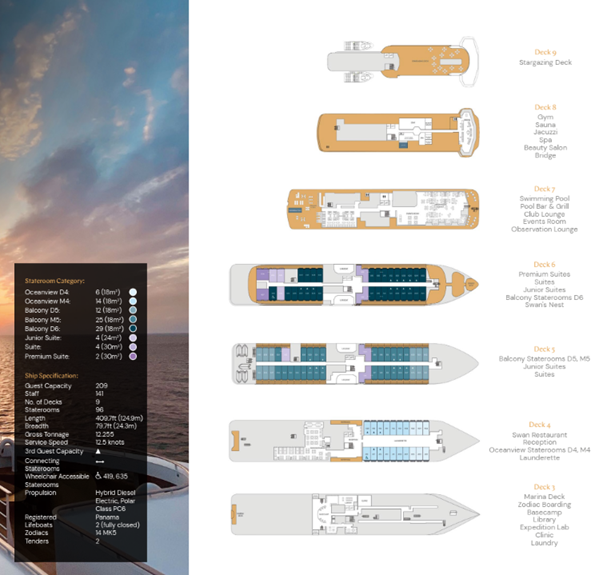Discover the Adriatic's dazzling coastal gems, starting in Venice, the Queen of the Adriatic, and concluding in Piraeus near Athens, showcasing a rich tapestry of history, culture and breathtaking landscapes. Visit Croatian gems, witness island villages and explore enchanting medieval old towns such as Trogir, Split, Dubrovnik and the magical Kotor in Montenegro. Marvel at the beauty of the Adriatic coast, as you cruise on to Albania and Greece.
- Dubrovnik: Explore the immaculate medieval city walls encircling Dubrovnik's Old Town, where red-tiled rooftops and historic landmarks like the Franciscan Monastery and the Gothic-Renaissance Rector's Palace await discovery.
- Kotor: Discover the UNESCO World Heritage site of Kotor, nestled at the end of Boka Bay, where medieval cobblestone alleys lead to Romanesque churches and the towering St. John's Fortress offers panoramic views over the town and surrounding cliffs.
- Corinth Canal: Experience the engineering marvel of the Corinth Canal, a historic waterway cutting through the narrow Isthmus of Corinth, offering a glimpse into ancient and modern Greek maritime history as you cruise through its impressive passage.
Prices quoted here are often dependent on currency fluctuations. Please check with (01432 507450 or info@small-cruise-ships.com) for the very latest price, which may well be cheaper than the one advertised here.








Venice, the capital of northern Italy’s Veneto region, is built on more than 100 small islands in a lagoon in the Adriatic Sea. It has no roads, just canals – including the Grand Canal thoroughfare – lined with Renaissance and Gothic palaces. The central square, Piazza San Marco, contains St. Mark’s Basilica, which is tiled with Byzantine mosaics, the Doge's Palace and the Campanile bell tower offering views of the city’s red roofs.
The medieval charm of Rab Town on Rab Island is evident in its winding alleys, Romanesque bell towers and churches, and 15th-century Renaissance palaces that line the palm-fringed port. This UNESCO-listed old town blends sacred and secular monuments. The island is also known for sandy beaches on the Lopar Peninsula, which along with diverse landscapes, from pine forests to windswept barren coasts, earned Rab geopark status in 2008.
Sitting on an islet within imposing city walls, Trogir Old Town, a UNESCO World Heritage Site, features medieval charm. Narrow cobblestone alleys weave among 13th to 17th-century buildings. The Duke's Palace, a 13th-century Gothic masterpiece, overlooks the main square near the Romanesque-Gothic Cathedral of St. Lawrence, adorned with intricate carvings. Beyond the walls, the lively Riva promenade boasts sea views and overlooks Ciovo Island.
Dubrovnik is renowned for its immaculate medieval city walls that encircle the Old Town, offering views of red-tiled rooftops and the sea. Stradun, the main street, runs through the UNESCO World Heritage site. With a harmonious blend of architectural styles, from baroque to Renaissance, highlights include the Franciscan Monastery featuring a Romanesque cloister and the Rector's Palace, a splendid example of 15th-century Gothic-Renaissance design.
Kotor sits at the end of Boka Bay, a UNESCO World Heritage site ringed by towering limestone cliffs. Its old town walls hide medieval cobblestone alleys, Romanesque churches like St. Tryphon’s Cathedral, and Kotor’s cats, said to be descendants of ancient seafaring felines. At 260m, the towering St John's Fortress overlooks town, and is accessed via a hike up 1,350 steps. Mount Lovcen looms over, accessible via serpentine road or cable car.
Gliding through the Bay of Kotor's narrow entrance is breathtaking. Ships cruise past Yugoslav submarine tunnels then the Verige, the bay's narrowest point. The island Church of Our Lady of the Rocks appears, its dome rising from the shimmering water, one of the Adriatic's most photographed sights. Perast, a postcard-perfect baroque village, comes into view with bell towers and red-roofed houses hugging the bay's edge.
The Albanian Riviera stretches along a beautiful section of the Ionian coastline. Sarandë is its unofficial capital, whose original settlers were said to be descendants of ancient Greek hero Achilles. Today crowds flock to Sarandë to enjoy the beaches and bustling nightlife. Outside the city, a plethora of UNESCO-listed ancient ruins include the Ancient City of Butrint, considered one of the most important archaeological sites in Albania.
An important historical place, the harbour town of Itea sits below Mount Parnassus, home to the mythical Muses and the winged horse Pegagus. It's near the ancient Greek sanctuary of Delphi where Pythia, the Oracle, prophesied the words of Apollo Pegasus. In 1827, Itea witnessed the Battle of Agali during the Greek War of Independence. The mountain region hosts one of the oldest and largest olive groves.
The Corinth Canal links the Gulf of Corinth with the Saronic Gulf in the Aegean Sea. Cutting through the narrow Isthmus of Corinth, it divides the Peloponnese from the Greek mainland. At 6.4 km long and 21.3 m wide at its base, it's impassable for most large ships. Commissioned by Greek tyrant Periander in the 7th century BC, it stayed incomplete until the late 19th century, when modern engineering techniques finally completed it.
Greece's cosmopolitan capital, Athens, connected by Piraeus port, is an exciting blend of ancient and modern. The Grand Promenade seamlessly links the city's main archaeological sites, and a visit isn't complete without exploring the Acropolis—a hill housing ancient ruins, including the iconic Parthenon. For deeper insights, the Acropolis Museum awaits, and a marble path ascends Filopappou Hill, offering majestic views of the 'high city.'
Itineraries are subject to change.
Diana

| Length | 125 metres |
|---|---|
| Launched | 2022/23 |
Launched in 2023, SH Diana provides elegant and spacious 5-star accommodation for 192 guests in 96 spacious staterooms and suites, the vast majority with large balconies. Operated by an onboard team of 140 she provides a high level of personal service, exploring the Mediterranean and its famous sites of antiquity.
Now sit back, relax and take a moment to get to know this amazing new ship, purpose-designed for our unique cultural expedition cruises.
Named after the Ancient Roman goddess of light, the moon, hunting and the wilderness, SH Diana been specially designed for worldwide cruising to explore the most inspiring and inaccessible places on earth. Building on the outstanding amenities of her sister ships, she adds a dedicated Multifunctional Room next to the Observation Lounge, a Private Dining Room for special occasions, and two tenders which bring guests a comfortable alternative to Zodiacs for expedition landings. A Polar Class 6 ice-strengthened hull combines with extra-large stabilisers to make your journey as comfortable as possible.
SH Diana has been designed for immersive experiences, with extensive outside deck areas, multiple observation points and bright, open and relaxing public spaces with unobstructed views.
The pleasure and safety of our guests is paramount at all times, cared for by our attentive crew and seasoned expedition leaders. Cutting edge hygiene technology protects the health of all on board to the highest standards and includes air conditioning with UV sanitisation systems.
SH Diana’s 96 staterooms , including 11 suites, are each a superbly comfortable home from home and all feature panoramic sea views, a flame-effect fireplace, original works of art, plush couches, premium pocket sprung mattresses, en-suite bathrooms with glass-enclosed rain showers, and Egyptian cotton towels, bathrobes and sheets. A pillow menu offers customised head and neck comfort during rest, while a large flat screen TV, espresso machine with Illy premium coffee, tea making facilities with the finest Kusmi teas, and a minibar with refreshments enhance relaxation at any time. In-room dining is of course available at all hours.
Wheelchair access
Guests who use wheelchairs must bring their own, as we have only a small number of wheelchairs stored onboard for emergencies. To ensure ease of movement on the ship, wheelchairs and mobility aids must be no wider than 65cm. All mobility or medical equipment brought on board must be capable of being carried safely and must be declared before sailing. To ensure that all guests can safely evacuate during an emergency, guests requiring a wheelchair can only be accommodated in our ADA-accessible cabins.
We offer an Oceanview and a Balcony stateroom on Diana. These staterooms are specifically designed to be completely ADA compliant and have a fully operable wheelchair-access wet unit.
Diana has two lifts, serving every passenger deck apart from the Stargazing top deck, which is, therefore, more difficult to access, as are the Aft Marina and Swan’s Nest forward observation platform. Also, we don’t have special equipment to access the swimming pool, jacuzzi, or sauna. Otherwise, the ship is entirely at your disposal.
Many of the expeditions ashore in remote places are by Zodiac. Boarding these boats and returning aboard can present challenges for wheelchair users, as can navigating uneven terrain. These challenges are by no means always insurmountable, though, and our highly experienced crew is trained to provide reliable advice and assistance. They will make every effort to ensure wheelchair-using guests enjoy a memorable experience at each destination. Our general guidance, however, is to recommend wheelchair users travel with a companion for their ease and enjoyment.
If you prefer to remain aboard, our panoramic interiors and ample open decks ensure an immersive, intimate experience of your inspiring surroundings.

Book before 31 March, 2025 and save 15%
15% discount off booking made on specific departures
Offer valid if booked before 31/03/2025
Only applies to new bookings.
This offer can be withdrawn at any time.
This offer is subject to availability.

